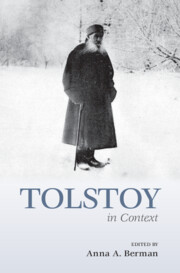Book contents
- Tolstoy in Context
- Tolstoy in Context
- Copyright page
- Contents
- Figures
- Notes on Contributors
- Preface
- Acknowledgments
- Note on Citations, Translations, and Transliterations
- Chronology
- Part I The Man
- Part II Russian Social and Political Contexts
- Chapter 5 Peasants and Folklore
- Chapter 6 The Great Reforms
- Chapter 7 Nobility and the Russian Class System
- Chapter 8 The Russian Orthodox Church
- Chapter 9 Law
- Chapter 10 Politics
- Chapter 11 War and the Military
- Chapter 12 Tolstoyans
- Chapter 13 Clothing
- Chapter 14 The “Woman Question”
- Chapter 15 The Family
- Part III Literature, the Arts, and Intellectual Life
- Part IV Science and Technology
- Part V Beyond Russia
- Part VI Tolstoy’s Afterlife
- Suggested Further Reading
- Index
Chapter 6 - The Great Reforms
from Part II - Russian Social and Political Contexts
Published online by Cambridge University Press: 05 January 2023
- Tolstoy in Context
- Tolstoy in Context
- Copyright page
- Contents
- Figures
- Notes on Contributors
- Preface
- Acknowledgments
- Note on Citations, Translations, and Transliterations
- Chronology
- Part I The Man
- Part II Russian Social and Political Contexts
- Chapter 5 Peasants and Folklore
- Chapter 6 The Great Reforms
- Chapter 7 Nobility and the Russian Class System
- Chapter 8 The Russian Orthodox Church
- Chapter 9 Law
- Chapter 10 Politics
- Chapter 11 War and the Military
- Chapter 12 Tolstoyans
- Chapter 13 Clothing
- Chapter 14 The “Woman Question”
- Chapter 15 The Family
- Part III Literature, the Arts, and Intellectual Life
- Part IV Science and Technology
- Part V Beyond Russia
- Part VI Tolstoy’s Afterlife
- Suggested Further Reading
- Index
Summary
This chapter explains the Great Reforms of Alexander II, and Tolstoy’s complex response to them in his work. It explores the basic structure of serfdom, and the ways in which it was fundamental to Russian social and economic structures in first half of the nineteenth century. The chapter explains the process of emancipation, and how it gave serfs a degree of freedom while still keeping economic and social power in the hands of the landowners. Tolstoy recognized serfdom as unjust, but also owned serfs and made only an ineffectual attempt to partially free them before the official end of serfdom in 1861. In his works, serfdom is described as oppressive but also connected with love and family. His works also reflect his concern that emancipation would destroy the nobility without solving the fundamental problems of poverty and exploitation. The creation of the zemstvo as a system of local government was a similar source of ambivalence for Tolstoy. He served in his local zemstvo for some years, but in his fiction the zemstvo is shown as an inadequate solution. His later works suggest that a more radically empathetic solution is needed to break down the barriers between peasants and landowners.
- Type
- Chapter
- Information
- Tolstoy in Context , pp. 47 - 53Publisher: Cambridge University PressPrint publication year: 2022

